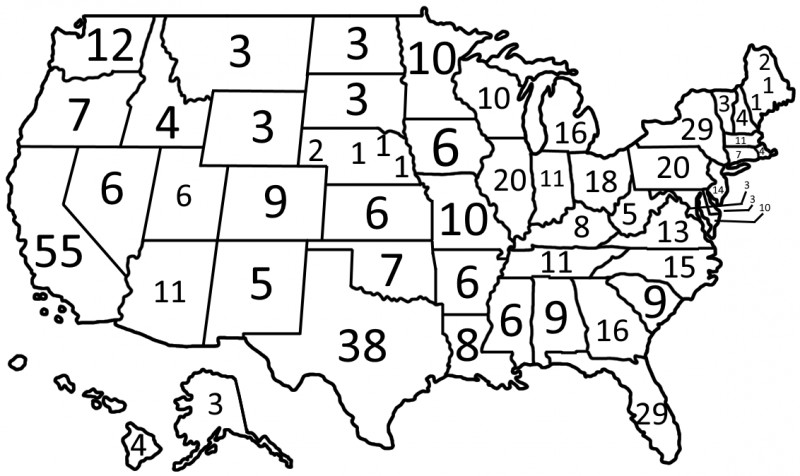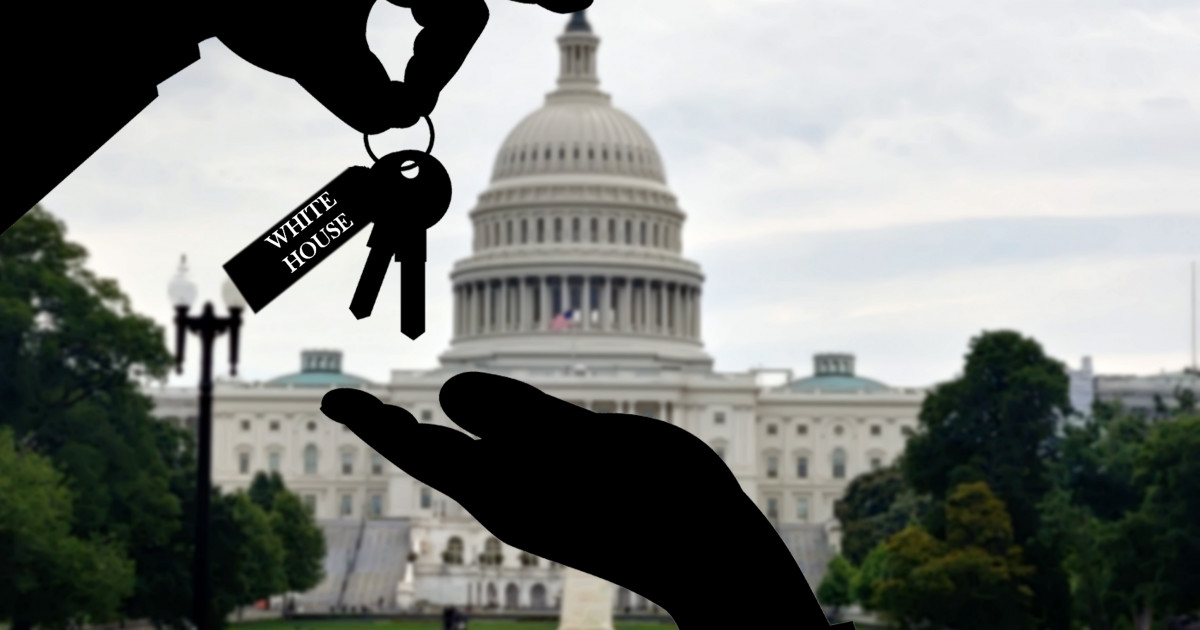U.S. voters cast their ballots in the presidential race a month ago, but the vote to elect the next president and vice president of the United States is set for Monday, December 14th. In 50 states, 538 voters will cast ballots in the federal capital, Washington DC. Next, about how this system works and what we can expect from Monday’s vote.
U.S. presidential elections, unlike other presidential elections in other countries, are indirect elections in which the American voter does not vote for a candidate, but for certain voters to choose that candidate on his or her behalf. However, paradoxically, the names of the presidential and vice presidential candidates will appear on the ballot, along with their partisan affiliation – (D) to the Democratic candidate and (R) to the Republican.
Thus, American citizens go to the polls and decide which of the two parties’ voters will have the right to vote in the Electoral College. When a candidate wins an election in that state, the result goes through a verification process in which state officials confirm the decision and determine who will vote in college. This year, after elections in all 50 states have been verified and ended on December 8, it marks the victory of Joe Biden and Kamala Harris with 306 voters compared to the 232 of Donald Trump and Mike Pence.
In general, voting in an electoral college is a simple process. In the elections of the last decades, there have been no incidents related to the serious observance of popular vote in individual states, nor has the situation changed.
However, voting in this year’s election college is highly anticipated, in the context of Donald Trump, who was defeated in the election, refused to accept his defeat and sought to overturn the decision in a number of ways, including in court or under pressure. To local politicians in the states.
What, exactly, is Election College
When the United States Constitution was drafted, the country’s founding fathers fought to determine how the country’s leadership would be elected, especially if it was not nearly as strong in America’s identity. There were also major problems with institutional integration – some states had enslavement as an institution guaranteed by law, while others abolished it, but there were many differences in organizational or institutional perspective.
The founding fathers of the United States thought of this system as a balance of power between states, many of which, as we have mentioned, do not apply in many respects, including interests. It is possible for Congress to elect a president, but this institutional structure would have made the country a parliament and created an imbalance between the legislature and the executive. The second possibility is a direct popular vote, but the founding fathers of the United States have always feared a “mob dictatorship” and a coup d’விபtat and a direct democracy.
Compromise Settlement is the institution of the College of Elections. Each state has its own population data, allocated on the basis of multiple electoral votes, and the entire war is concentrated on these electoral votes, but also the strategy of the candidates. With a few exceptions, election votes are won on a win-win basis. Basically, the candidate who gets the majority Votes receive all the electoral votes of the respective state.
Exceptions to this rule are two states – Nebraska and Maine. The two divide their electoral votes into three separate federal districts, with one candidate being able to get the popular vote in the state as a whole, but losing one district and the associated electoral votes. There are four constituencies in Nebraska – one giving the winner 2 votes and the other three constituencies. In Maine, the first district casts 2 votes and the other two.
All other states cast their ballots for the statewide winner. The candidate who wins in New York State, for example, will receive his or her 29 electoral votes, regardless of the percentage of votes he or she receives at the state level. He can win this state by a margin of one vote or he can win it by a margin of 99% of the vote, but the result will be the same – he will get 29 votes.

Who the voters are and where they meet to vote
Following the verification of election results in a particular state, the authorities establish a set of voters who will take part in the actual final ballot. Generally, the officials who complete this process are the Governor of the State and the Secretary of State. Before each party goes to the polls, voters in each state will be nominated if their candidate wins the election. For example, Democrats and Republicans will determine who their voters are for the state of Georgia. When one of the candidates is confirmed as the winner and the result is certified by the state, the voters of the winning party will vote for that state. This year, Joe Biden defeated Georgia, so once the results are verified, the voters nominated by Georgia will be Democrats.
There are a total of 538 electoral votes, and to be elected President of the United States, a candidate must receive 270 of them, i.e. half +1.
Voters are usually key party figures, elected officials, “young believers” or old party loyalists who want to make a name for themselves in politics. For example, Christy Noem, a staunch supporter of Donald Trump, or Stacy Abrams, a former Georgian Democrat who played a key role in Biden’s victory in that state, will vote in election college this year. In New York, voters will include Harare Clinton, a former 2016 Democratic nominee, former First Lady and former Secretary of State in Barack Obama’s first office. Basically, only those who are elected as voters have the least risk of betraying and voting with someone other than the candidate who won the state election. In this context, according to the historical paradigm, voting in the Electoral College is very unlikely to be completely different from the estimates of 306-232 in 2020, based on official state verification.
Not all 538 voters voted in one place. In each state, the legislature decides where the referendum will take place, and elects the electorate in that state. Each voter has two ballots, one for the president and the other for the vice president, who writes his or her choice by hand. In most states, voters can vote for whomever they want – they do not need to vote for any candidate in the election. However, there are also states that punish “unfaithful voters” and the party may withdraw the voter’s order at the last minute and appoint a more loyal person to replace him. However, such incidents are rare, mass defeats on the part of the electorate, enough to change the outcome of the election, never happened.
Following that, the votes are counted and each voter signs a certificate of six results. The state governor will also write his own certificate describing the outcome of the vote. These reviewed certificates are sent to a number of companies, but the most important is the one sent to the President of the US Senate (Vice President of the United States). This last copy will be officially counted.
After all the votes in all the states have been registered, these certificates reach the Congress which is officially counted. It takes place on January 6, and finally, the Vice President of the United States, in his post as President of the Senate, officially confirms the outcome of the vote.
This low-tech voting system is a feature of the American system, a “time capsule” that technology still does not allow information to flow as fast today. This is why the official data of these administrative activities are so far different.
What can we expect from Monday’s vote
In general, the results should be very clear – if all states have already checked the election results and decided who the voters are, Joe Biden and Kamala Harris should win the election college by a margin of 306 votes. 232. However, things are complicated by the President’s determination to disrupt the process and try to overturn the election result.
On the other hand, not only did he fail globally in his appeal to the court, but considering the number of voters who exceeded the Joe Biden 270 limit, the result was unlikely to be overturned.
On Saturday, the U.S. Supreme Court rejected without further discussion another attempt by Trump to block decisions in four key states: Georgia, Michigan, Wisconsin and Pennsylvania. Trump, through the Texas Attorney General, one of his spokespersons, who is believed to be seeking a presidential pardon, sought to initiate a wide-ranging process between Texas and the four states mentioned. According to the complaint, Texas claimed that the election results in four states were invalid because they violated its own election laws, and that this “defective result” would have affected the American citizens of Texas as well. The fact that this last attempt should be rejected, however, is predictable, as most judges felt from the outset that such a case could not be taken seriously by the Supreme Court. He was unanimously rejected by the judges, three of whom were appointed by Trump. Two of them, Samuel Alito (named after George W. Bush) and Clarence Thomas (named after George H. W. Bush), however, agreed to hear the arguments of the trial, but nothing more.
Earlier, the Supreme Court unanimously dismissed another such case. Trump’s allies sought to attest to the decision in Pennsylvania, believing that the Republican-controlled state legislature would be able to determine who the 20 Pennsylvania voters were.
Many attempts by Donald Trump, his allies and his speechwriters to overturn this decision have failed almost worldwide. During this time, the current president has lost 54 cases in the lower and state courts and two in the Supreme Court. So far, the judges have ruled in his favor in only one case – a practical success in counting votes in Pennsylvania, when the judge agreed to reduce the grace period for absentee ballots from 9 to 6 days.


:max_bytes(150000):strip_icc()/IrinaBaeva8-e93ba8209a3d48289ce75f8a4da1b936.jpg)

